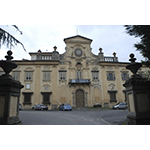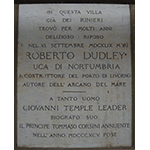Villa Corsini a Castello
Giorgio Vasari was the first to mention the villa in the 1568 edition of his Vite dei più eccellenti pittori, scultori e architetti [Life of the most excellent painters, sculptors and architects]. At that time, the complex, known as "I Rienieri" in reference to the illustrious Florentine family that owned it, was distinguishable by its dignified monumentality, still represented by the northern and western facades. The gardens surrounding this pleasurable place at the gates of Florence must have been just as much remarkable. Nicolò Tribolo realized a colossal sculpture of Fiume precisely intended for the northern garden, also known as the "Ragnaia". The original conception and refined execution of the sculpture allowed it to be cited in Vasari's work. It was in this noble building, in the immediate neighborhood of the medicean Villa della Petraia, that resided Robert Dudley, during the first years of the 17th century. As recalled by the commemorative plaque placed by John Temple Leader on the façade of the villa, it was here that stayed until his death, in 1649, the famous British cartographer and naval architect who was placed under the patronage of the Medici family in 1606. Are ascribed to him reorganization of the port of Leghorn, the conception of powerful warships intended for the fight against the North frican Barbary pirats and, above all, the composition of the treatise Dell'Arcano del mare, the first maritime atlas of the modern times. The latter work, dedicated to Ferdinando II, was printed in Florence in 1646 and was supplied with some 130 maps that illustrated the entire known world with a precision never shown by portolan charts until then. The spectacular collection of scientific instruments owned by the English naval engineer and geographer, that contains rare examples of instruments to measure the tides, theodolites and quadrants, was first housed in the Room of Mathematics of the Uffizi Gallery for two centuries; part of it is now visible in the Museo Galileo of Florence.
The acquisition, in 1697, of the villa by Lucrezia Rinuccini, wife of the marquis Filippo Corsini, is considered a decisive turning point in the history of the architectural complex. It was, in fact, essential to endow the property with a new monumentality worthy of the importance of the new owners. This led to its radical remaking and gave a spirited late baroque aspect that characterizes it still today. Giovan Battista Foggini, put in charge of the reorganization of the new property by Filippo Corsini, rather than remove the existing structures, accepted the difficult challenge to incorporate the renaissance structure into a lively baroque complex which finds its highest point in the architectural ascent of the façade's central zone. Furthermore he established «a direct dialogue with the garden and the surrounding landscape through precise perspective relations».
To the renovation of the exterior fronts correspond a reorganization of the interior volumes surrounding a sumptuous reception room that provides a testimony of the innovative originality of Foggini's work. The frescos dating from 1801 were made by Niccolò Contestabile, a Pontremoli native painter that worked for the Florentine court, and represent Latium landscapes filled with ancient ruins; amongst these, it is possible, for example, to identify the so-called Sibyl's temple of Tivoli, the Plautii mausoleum at Pontelucano and the Hercules' temple of Cori.
From the mid-20th century, the villa was subjected to an unrelenting process of decline which not even the passage under State property, completed in 1971, could contain. It was only during the last decades that a difficult and systematic intervention plan was adopted, reaching its highest point with the restoration of the principal façade, thanks to funds provided by the Ente Cassa di Risparmio di Firenze. The successful intervention gave to the property its original splendor.
Today Villa Corsini is even a precious setting for the maintenance of a collection of ancient marbles amongst the most important in Florence for the number and quality of the exhibits. These statues, gathered at the end of the 19th century in the newly formed Archaeological Museum of Florence, come largely from the Uffizi's collections. Transferred to Villa Corsini in the last quarter of the 20th century, the group of ancient marbles, which counts some authentic masterpieces such as the Sleeping Ariadne and the Gowned Man made of Egyptian porphyry, was meticulously catalogued and reorganized according to a new expositive plan. In 2010, the museum was inaugurated proposing to the public a path that unfolds through fifteen monumental rooms filled with over 100 sculptures, sarcophagus, epigraphs and reliefs of Etruscan , Greek and Roman origins.
****************************
Texts by Fabrizio Paolucci
English translation by Ghada Belhadj
Last update 12/mar/2014





